Glacier Ridge Metro Park- the Honda Wetlands
Barn Swallow
Tree Swallow
Mallard
Pied-Billed Grebe
American Coot
The Honda Wetlands is a great birding spot in central Ohio. Located in Union County between Dublin and Marysville, this facility is part of Glacier Ridge Metro Park, and is sited 2 miles south of the main entrance. A greenway trail connects both sections of the park for use by pedestrians and bicyclists. It consists of 250 acres of restored wetland habitat in a rural setting, though there are higher-income housing developments being built in the area.
There is a nature education center shelter house by the parking lot, with a gourd nesting pole nearby. There are tree swallow nesting boxes in the adjacent field. Needless to say, this area is popular with swallows.
The shelter house offers a close-up view of the adjacent wetlands.
There is a very nice mural here showing commonly-seen wildlife of the area. There’s a a key that allows you to look up the names of what you’re looking at, which is icing on the cake!
I’m glad to see that so many agencies came together with Honda of America to make these restored wetlands possible.
The shelter house is quite popular with local Barn Swallows, who love to nest on buildings. You can see them frequently hanging out on the roof. No doubt many of these are the nestlings that I observed last month being cared for by their parents.
Tree Swallows hang around on the gourd nests a lot. I’ve heard Purple Martins flying overhead on occasion.
Near the shelter house are three huge Bur Oak trees; I wonder if a century has passed since they sprouted? Baltimore Orioles and several other species can often be glimpsed in their branches.
A short distance from the shelter house is the observation tower, which provides a convenient view over the wetlands area.
There are two spotting scopes at the tower.
Another nice touch is signage showing commonly-seen bird species that inhabit the wetlands.
Although most of the nesting was over and done with by late July, one pair of Barn Swallows had 3 little ones in a nest underneath the tower platform.
The parents would anxiously circle the tower if anyone was near their nest, chirping little cries.
As soon as the way was clear, the nestlings would be fed a steady diet of insects caught on the wing by both of their attentive parents.
Here’s the view of the area from the tower.
There’s a permanent pond to the east, popular with waterfowl.
The other wetland areas can dry up, but often have enough standing water. Mallards preen on a log down below.
It’s fairly common to run into birders and photographers at the tower and along the boardwalk, hoping to see elusive shorebirds or waterfowl. Most are a friendly bunch, chatting about what birds they’ve seen, and letting newcomers know where the birds of interest are.
The boardwalk runs out through the expanse of Broadleaf Cattails and other marsh plants such as Woolgrass and Softstem Bulrush.
You can sometimes hear birds such as rails and bitterns in the cattails, tantalizingly close.
This is a rabbit in the marsh, with only its ears showing above the foliage. It hopped through the grass barely visible to me, a mysterious moving object of interest.
There are lots of things to see here, but I will focus on juvenile ducks and duck-like birds I saw recently. In mid-summer, young waterfowl are present, having left the care of their parents. These are examples of how young birds can look different than adults, which can be a challenge for beginning birders.
Here are some Mallards, a very common and gregarious duck- these young ones prefer each others company. Lack of a speculum, a colorful patch on the flight feathers of the wings, means that they are not adults yet.
This Mallard has his speculum, but not his male plumage yet. His bill is yellow, indicating that he is a male. Female Mallards have black and orange bills, and their plumage changes little when they mature. This guy will develop a dark green head, white body feathers and a rust-colored breast.
This is a young Pied-Billed Grebe. My Golden Field Guide describes them as ‘a small, solitary stocky grebe with a unique chicken-like bill. Rarely flies, escapes by diving or slowly sinking beneath the surface.’ I like that description; visions of ‘farewell, cruel world!’ as this little guy sinks out of sight…when newly hatched, these fascinating birds ride upon their mother’s back and will react to danger by climbing up on mom until they learn to dive.
This handsome fellow is a young American Coot. This species has big lobed feet for walking on aquatic plants and soft wet ground. They are chunky birds, reminding me of chickens. This juvie will become darker and have a bright white bill upon reaching adulthood.
Here are two juvie Coot walking around on marshy ground- they look less duck-like this way. They have really large feet!
And, to wrap up this post, here’s all three species at once, enjoying the wetlands while humans enjoy the sight of them.
There’s lots more to see in the wetlands- but that will have to wait for future posts!


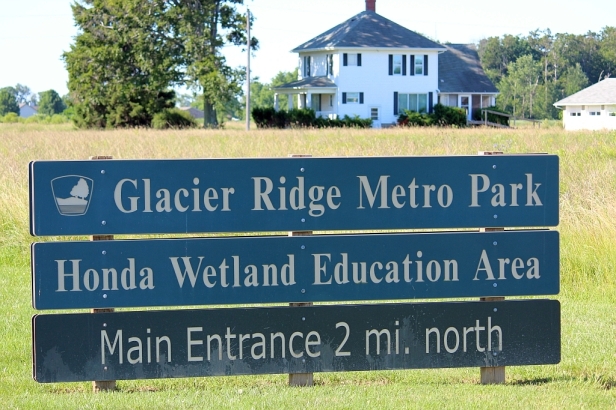
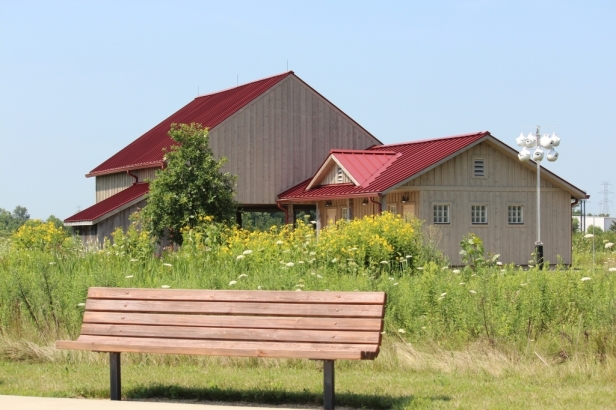
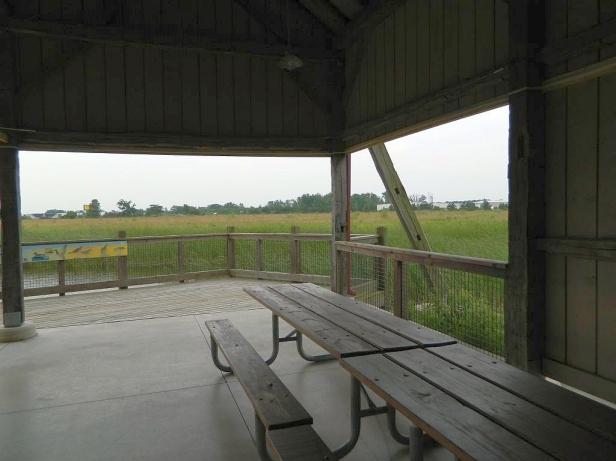

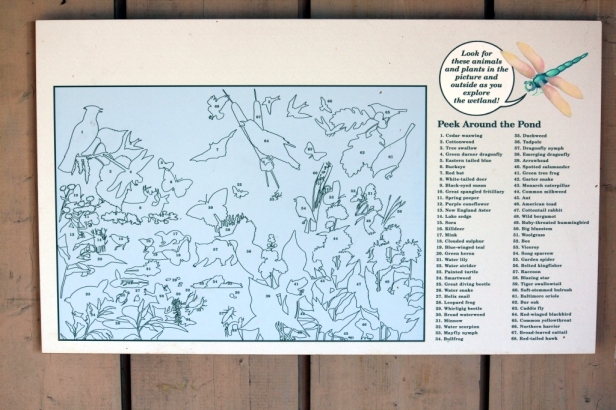

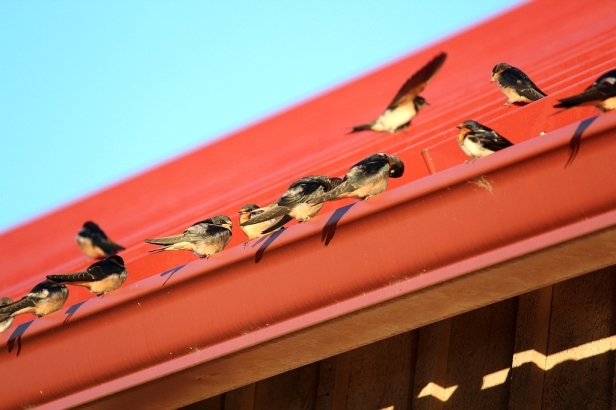










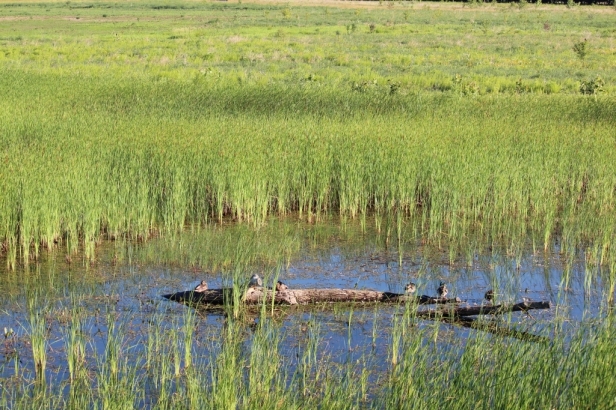







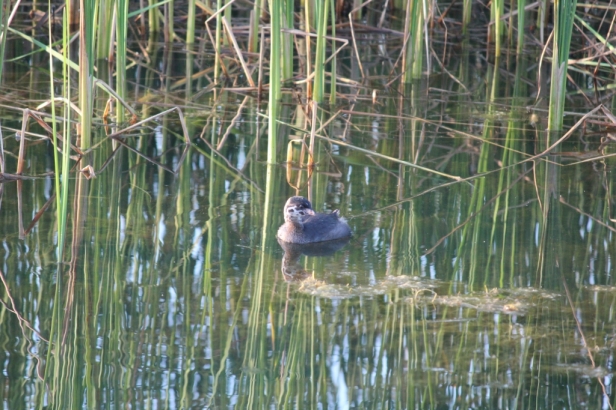



What a great Summer. The photos were amazing. Feels like I was there myself.
Wowzers, quite a post. I especially like the close up of the two birdies. So cute!
Wow, I would not have recognized the young coots for what they were, at least not without an adult nearby to clue me in. They look so different.
I had to double check that those truly were young coots, the adults as you know look almost like another species! That doesn’t make birding any easier, by the way…
Magnificent photos and wetlands. I think it would be soul inspiring to visit a place such as that and watch the wildlife of the region. The baby barn swallows are super cute. 🙂
I know I’ve posted pictures of swallow nestlings before, but I can’t help it! Heh
Beautiful place
WoW!! Such a georgous place! Every state should have one! I especially love the pictures of the Mallards!! Very pretty!
http://mylifencolor.wordpress.com
Thanks for the kind comments everyone- I’ll be posting occasionally about other parks in the area.
Thanks so much for visiting my blog and commenting; that allowed me to find YOUR blog! It’s full of beautiful nature photos, and I am subscribing so that I can follow you in the future. You certainly took time to share a lot of pictures here from your visit to the Honda Wetlands. It’s a place I will probably never get to visit in person, so seeing it through your lens in a special treat. 🙂
Your comment made my day! 🙂
I really enjoy your blog and especially the photos of the Honda Wetlands.
Thanks, Les! I’ve added your blog http://abirdersnotebook.wordpress.com/ to my Ohio nature blog links, I’ll be a regular visitor!
Thanks so much for sharing these. I can’t think of anything remotely like this near where I live, it would be wonderful to spend a day at such a site. I’m envious! Great pictures and wonderful educational material! 🙂
Thank you, Robin! I’m very lucky to be within reasonable driving distance of this restored wetland.
Again, great post…and I love the wetlands…as a kid we had them all around us…since we lived in the “low rent” district, the “other side of the tracks”, whatever…and we called it, “The swamp”…today, as you mentioned, upscale houses “want” to be near “wetlands”…for I hope all the right reasons…I remember so well all those hours we spent “in the swamp”…with the “spring melt” came “floating down the river on a Huck Finn home-made raft”…and Red-wing blackbirds on the attack…for being in “their” swamp…and so much more…loved “the swamp”…
Most of those are gone now, so it is heartening to see “swamps” (sorry can’t help myself) being restored…loved to see the birds and frogs and ducks of my youth thriving…and you brought all that back…loved it…thanks…
Great memories, Jim! It never occurred to me that wetlands are desirable areas now, whereas back in the day ‘swamps’ were frowned upon. Times change!
How cool! That’s all I can muster here. I LOVE that observation tower!
agreed! It really is a unique design- whoever came up with it was quite creative!
What a thorough photographic tour! Great close-up of those nesting birds. I’m not a birder; I learned a new definition of “speculum.” So those birds aren’t gynecologists…
It’s always a good day to stumble upon a new definition! 😀
What a wonderful wetlands! I’m glad to read about it and see your photos. Makes me feel good!
Many thanks- fantastic pictures of Montana are only 1 click away from here: http://montucky.wordpress.com/
Thank you! You are very kind!